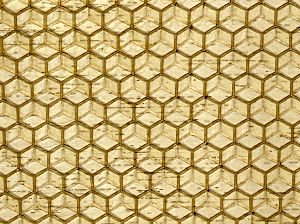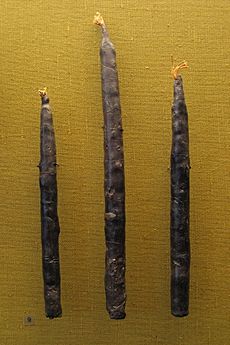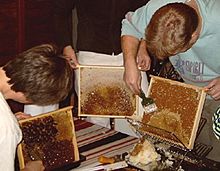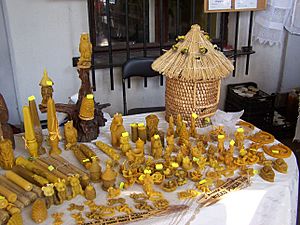Beeswax facts for kids

Beeswax is a natural wax that honeybees make. They use it to build their hives, which are like their homes. Beeswax is also used by people in many ways, such as in cosmetics (like makeup), medicine, and to make candles. You might even find it as a coating on some gelatin sweets or in ski wax. Sometimes, in medicine and physical therapy, beeswax is used to help with a cough, common cold, or muscle pain.
Contents
How Bees Make Wax
Worker bees are the ones that make beeswax. They have special wax-producing glands on the underside of their bodies. When a worker bee is young, these glands are active. But after many flights, the glands start to shrink and don't make as much wax.
When the wax first comes out, it's clear and has no color. But after the bees chew it and mix it with pollen, it becomes cloudy. The wax also gets more yellow or brown over time because of oils from pollen and a sticky substance called propolis (also known as bee glue). Each tiny piece of wax is about 3 millimeters (0.12 inches) wide and 0.1 millimeters (0.004 inches) thick. It takes about 1,100 of these tiny wax pieces to make just one gram of wax!
Honey bees use this beeswax to build the hexagon-shaped cells of their honeycomb. These cells are where they raise their young and store honey and pollen. For bees to make wax, the temperature inside the hive needs to be warm, between 33°C and 36°C (91°F to 97°F).
It takes a lot of honey for bees to produce wax. Some studies suggest that bees use about 6.66 to 8.80 kilograms (14.7 to 19.4 pounds) of honey to make 1 kilogram (2.2 pounds) of wax.
Getting and Cleaning Beeswax
When beekeepers collect honey, they have to remove the wax caps that seal each honeycomb cell. They do this using a special knife or machine. The color of beeswax can be different, from almost white to brownish. This depends on how pure it is, where the bees collected nectar, and what kind of flowers they visited. Wax from the part of the hive where baby bees grow (called the brood comb) is usually darker than wax from the honey storage areas. This is because more impurities build up in the brood comb.
Because of these impurities, the wax needs to be cleaned before it can be used. The leftover bits after cleaning are sometimes called "slumgum." To clean the wax, it can be heated in water. Beeswax can also be made softer and easier to work with at room temperature by mixing it with mineral oil or vegetable oil.
What Beeswax is Used For
Beeswax has many different uses. Its main purpose is for bees to build their honeycombs. But humans have found many other uses for it too! Cleaned and processed beeswax is used in food, cosmetics, and medicines. There are three main types:
- Yellow beeswax is the raw wax taken straight from the honeycomb.
- White beeswax is yellow beeswax that has been bleached or filtered to make it lighter.
- Beeswax absolute is yellow beeswax that has been treated with alcohol.
In food, beeswax is sometimes used as a coating for cheese. This helps keep air out and stops mold from growing. It can also be a food additive (called E901) in small amounts. It acts as a glazing agent, which means it helps prevent water loss or protects the surface of some fruits. You might also find E901 in coatings for soft gelatin capsules and tablets. Beeswax is also a common ingredient in natural chewing gum.
Beeswax is very popular in skin care and cosmetics. It's used in lip balm, lip gloss, hand creams, salves, and moisturizers. In makeup, you can find it in eye shadow, blush, and eye liner. It's also an important part of moustache wax and hair pomades, which help hair look smooth and shiny.
Making candles with beeswax has been done for a long time. Beeswax is very flammable, meaning it burns easily. Beeswax candles are often thought to be better than other wax candles because they burn brighter, last longer, don't bend, and burn "cleaner" (with less smoke). Beeswax candles are also traditionally used in the liturgy (religious ceremonies) of the Roman Catholic Church and the Orthodox Church.
Beeswax is also used in other interesting ways:
- It's an ingredient in surgical bone wax, which helps control bleeding from bones during surgery.
- It's found in shoe polish and furniture polish.
- It's used in modeling waxes.
- Pure beeswax can be used as an organic surfboard wax.
- Mixed with pine rosin, it can be an adhesive (glue) to attach parts inside musical instruments like a squeezebox.
- It can be used to make Cutler's resin, a glue for knife handles.
- In Eastern Europe, beeswax is used to decorate eggs, like in pysanky, where it's used for writing patterns on the eggs before dyeing them.
- Percussionists use beeswax to create a special surface on tambourines for certain playing techniques.
- It was once used to make phonograph cylinders (old music records).
- It can still be used to seal important legal documents or university degrees.
Beeswax Through History

Beeswax was one of the first "plastics" used by humans, along with other natural materials like horn and shellac. For thousands of years, beeswax has been used for many things. It has been found in ancient Egyptian tombs, old Viking ships, and Roman ruins. Beeswax is amazing because it never goes bad and can be heated and reused!
Historically, beeswax was used for:
- Candles: The oldest beeswax candles found north of the Alps date back to the 6th or 7th century AD in Germany.
- Cosmetics: Making beauty products.
- Sculpting: As a modeling material in the "lost-wax casting" process, which is a way to make metal sculptures.
- Writing: To make wax tablets for writing.
- Art: In encaustic paintings, like the famous Fayum mummy portraits.
- Tools and crafts: In bow making, to strengthen and protect sewing thread, cords, and shoelaces.
- Sealing: As a part of sealing wax.
- Musical instruments: To strengthen and prevent cracking of wind instrument reeds, and to form mouthpieces for instruments like the didgeridoo.
- Firearms: As a sealant or lubricant for bullets in old firearms.
- Explosives: To stabilize the military explosive called Torpex (before a petroleum product replaced it).
- Textiles: In producing Javanese batik, a method of dyeing fabric.
- Dentistry: As an ancient form of dental tooth filling!
Images for kids
See also
 In Spanish: Anexo:Materiales de apicultura para niños
In Spanish: Anexo:Materiales de apicultura para niños






